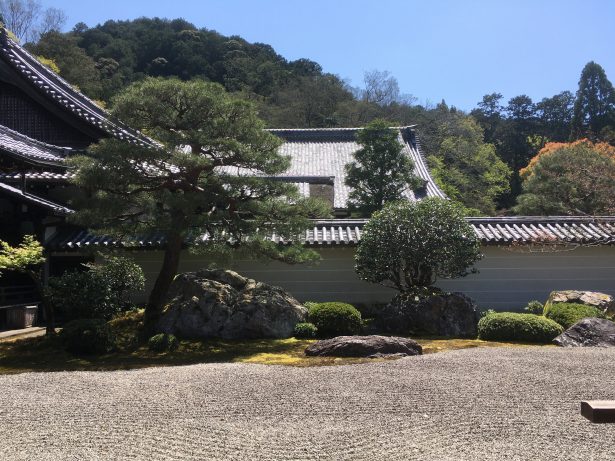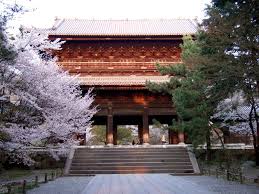春の京都 南禅寺 Nanzen-ji Temple Kyoto in spring

春の京都 南禅寺の歴史 The history of Nanzen-ji Temple Kyoto in spring
南禅寺は13世紀の終わりごろ(鎌倉時代)に創建された禅寺です。亀山天皇が僧の無関普門を招いて開山しました。江戸時代に入ると江戸幕府の外交関係を管轄した僧侶維心崇伝が南禅寺の住職となり、外交処理やキリスト教弾圧、朝廷と公家の統制を行いました。明治維新後には領地を大幅に没収され、境内は公共事業に使用されました。
Nanzen-ji Temple was built around the end of the 13th century (Kamakura period). Emperor Kameyama invited monk Mukan Fumon to open the mountain. In the Edo period( 1603-1868), The Monk Ishin Suuden who had jurisdiction over diplomatic relations between the Edo shogunate, became the chief priest of Nanzenji Temple, and he handled diplomacy, suppressed Christianity, and controlled the imperial court and the imperial family. After the Meiji Restoration, the territory was greatly confiscated, and the precincts were used for public works.
春の京都 南禅寺三門 Sanmon Gate Nanzen-Ji Temple Kyoto in spring

高さ22メートル。南禅寺の顔とも言える存在です。歌舞伎「楼門五三桐」の一場面にも登場する門で、盗賊石川五右衛門が「絶景かな絶景かな」とみえをきることで有名です。現在の三門が完成したのは1628年で、大名藤堂高虎が寄進したものです。徳川家康は既に没していましたが以心崇伝の影響力の大きさを物語っています。三門の前には高さ6メートル日本三大灯籠のひとつと言われる日本最大級の石灯籠も見どころのひとつです。
Height is 22 meters. It can be said that it is the face of Nanzenji Temple. It is a gate that also appears in a scene of Kabuki, and it is famous for seeing the bandit Ishikawa Goemon as “a superb view or a superb view”. The current sanmon gate was completed in 1628, and was promoted by Daimya Todo Takatora. Ieyasu Tokugawa had already died, but it tells the scale of the influence of Ishin Suuden. One of the highlights of sanmon is one of japan’s largest stone lanterns, which is said to be one of the three largest lanterns in Japan, which is 6 meters high.
春の京都 南禅寺方丈 Hojo Garden Nanzen-Ji Temple Kyoto in spring

密教系の僧侶は宮廷や公家との結びつきが強かったのに対して、禅寺は武家や豪商を有力スポンサーとして持っていました。住持は経済的支援者を方丈に招き政策や経営についてのアドバイスを行っていました。鎌倉時代のオピニオンリーダーである夢窓疎石も南禅寺の住持を務めました。大方丈庭園では奥深くに樹木を集中させ、手前に大きく空間を広げています。白河砂や花崗岩を砕いた「砂」は水を表現しています。「執着から脱する」という禅の目的の具象化であり、柔軟性の象徴でもあります。当時の武家や豪商も方丈庭園で制作談義に花を咲かせたことでしょう。狩野派の障壁画も見どころのひとつです。
While Esoteric Buddism monks had strong ties to courtiers and courtiers, Zen-temple had samurai and wealthy merchants as influential sponsors. Monks invited economic supporters to advise him on policy and management. Musou Soseki, the opinion leader of the Kamakura period, also served as the resident of Nanzenji Temple. In the Hojo Garden, trees are concentrated deeply, and the space is greatly expanded in the foreground. The “sand” that crushed Shirakawa sand and granite represents water. It is a concreteization of the Zen purpose of “out of attachment” and a symbol of flexibility. Samurai and wealthy merchants at that time would have bloomed in the production discussion in hojo garden. One of the highlights is the barrier paintings of the Kano school.
春の京都 南禅寺 水路閣 Suirokaku Nanzen-Ji temple Kyoto in spring

明治維新に伴う東京遷都の影響で京都の経済は大きく落ち込みました。経済復興の起爆剤となったのが琵琶湖疏水の建築です。水路閣は琵琶湖疏水の分線にあたります・当時の京都府知事北垣国道が主導し、田辺朔朗が設計しました。仏教寺院内部にあるモダンな建築物は伝統と革新が共存する京都のシンボルと言えるでしょう。
Kyoto’s economy dropped significantly due to the move to Tokyo following the Meiji Restoration. The construction of Lake Biwa Canal was the catalyst for economic recovery. The Hydrographic Pavilion is a watershed of Lake Biwa Canal, led by The Governor of Kyoto Prefecture At that time, The Kitagaki Kunimichi, and was designed by Sakuro Tanabe. The modern architecture inside the Buddhist temple is a symbol of Kyoto where tradition and innovation coexist.
関連する投稿
現在の記事: 春の京都 南禅寺 Nanzen-ji Temple Kyoto in spring






